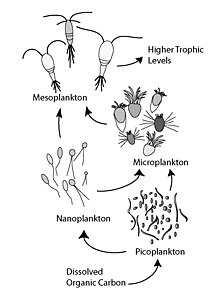Microbial loop

The microbial loop is a term coined to describe a trophic pathway in aquatic environments where dissolved organic carbon (DOC) is reintroduced to the food web through the incorporation into bacteria. Bacteria are consumed mostly by protists such as flagellates and ciliates. These protists, in turn, are consumed by larger aquatic organisms (for example small crustaceans like copepods).
The DOC is introduced into aquatic environments from several sources, such as the leakage of fixed carbon from algal cells, lysis of bacteria by marine bacteriophages and the excretion of waste products by aquatic animals and microbes. DOC is also produced by the breakdown and dissolution of organic particles. In inland waters and coastal environments, DOC can originate from terrestrial plants and soils. For the most part, this dissolved carbon is unavailable to aquatic organisms other than bacteria. Thus, the reclamation of this organic carbon into food web results in additional energy available to higher trophic levels (e.g. fish). Because microbes are the base of the food web in most aquatic environments, the trophic efficiency of the microbial loop has a profound impact on important aquatic processes. Such processes include the productivity of fisheries and the amount of carbon exported to the ocean floor.
History
Early work in marine ecology determined the role of bacteria in oceanic environments was considered to be minimal. Traditional methods of counting bacteria (such as culturing bacteria on agar plates) only yielded small numbers of bacteria in seawater. The classic paradigm of the ocean food web viewed planktonic algae like diatoms as the base of the food web. Because of the relatively large cell body size of some of these diatoms, they were retained on the plankton collection nets used by researchers (~ mesh size > 60 μm). These algae were considered to be the main food source of small crustaceans and thus the base of the ocean food web (sometimes this is referred to as the “classic food chain”). Increased scrutiny and the development of new methods and technology lead to the understanding of a higher importance of marine bacteria in ocean environments. For example, the method of staining bacteria with a fluorescent dye and concentrating cells on a membrane filter (with pores smaller than most bacteria) lead to a reassessment of the concentration of bacteria in seawater, typically in the order of 1 million per milliliter (1 billion per liter). Other work demonstrated that high respiration rates in seawater where larger organisms are screened out, indicating a highly active and dynamic microbial community in seawater.
In 1974, Larry Pomeroy published a seminal paper in BioScience entitled "The Ocean’s Food Web, A Changing Paradigm", where the key role of microbes in ocean productivity was highlighted.[1] While this article was received with some skepticism, more evidence began to strengthen and support Pomeroy’s hypothesis. In the early 1980’s a panel of top ocean scientists met to discuss this topic and the wider microbial food web. This group published the synthesis of their discussion in 1983 in Marine Ecology Progress Series entitled "The Ecological Role of Water Column Microbes in the Sea".[2] This paper coined the term "microbial loop" and noted that the bacteria-consuming protists were in the same size as phytoplankton and likely an important component of the diet of planktonic crustaceans. Evidence accumulated since this time has indicated that some of these bacterivorous protists (such as ciliates) are actually selectively preyed upon by these copepods.
References
- ^ Pomeroy, L.R. (1974). "The Ocean's Food Web, A Changing Paradigm". Bioscience. 24: 499–504.
- ^ Azam, F.; Fenchel, T.; Field, J.G.; Gray, J.S.; Meyer-Reil, L.A.; Thingstad, F. (1983). "The ecological role of water-column microbes in the sea". Marine Ecology-Progress Series. 10: 257–263.


